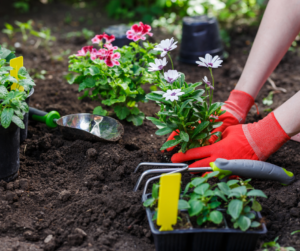February Garden Tips
 These February Garden Tips are essential to get your garden ready! In all but the warmest parts of the South, celebrate spring early by bringing branches of flowering shrubs and trees inside to force the blooms.
These February Garden Tips are essential to get your garden ready! In all but the warmest parts of the South, celebrate spring early by bringing branches of flowering shrubs and trees inside to force the blooms.
Cut stems of redbud, flowering pear, serviceberry, magnolia, flowering quince, or any of your favorite spring bloomers. Create unusual arrangements with stems of plants that bear catkins. This includes Corylus shrubs and alder and birch trees.
Once you bring the branches inside, submerge and recut stem ends under water. Plunge freshly cut ends in a clean bucket filled with floral preservative. Place the branch-filled bucket in a cool spot, such as a garage or porch. Allow stems to fully hydrate; it will only take a few hours.
Use the stems to create spectacular indoor arrangements. Fill vases with floral preservative solution to keep bacteria at bay. Change the solution weekly or whenever it’s cloudy. Add the cut stems, and watch buds swell and burst into bloom.
Learn more about forcing branches.
Test Garden Tip: For longest vase life, gather daffodil blooms for bouquets just as buds start to show color.
Start Spring Planting
Now is the time to get these plants started in your Southern garden.
Roses. Get roses in the ground now so they’ll be established before hot weather arrives. Choose bare-root roses for all but the warmest parts of the South. In the warmest areas, select container-grown plants.
Veggies. Plant potatoes, onions, lettuce, and spinach in all but northernmost areas. In northern areas of the South, wait a few weeks.
Trees. Add trees to your landscape this month. Select trees that are compatible with your soil type. Consult your extension service or a knowledgeable local garden retailer. Plant bare-root trees unless you garden in the warmer reaches of the region. Container-grown trees are a better option for the warmer areas.
Bedding plants. Set out cool-season annuals in cooler areas. Because cool-season annuals tolerate frost, they can be planted in areas where temperatures may drop. Lobelia, pansy, dianthus, and snapdragon are all good options.
Perennials. Create pots of spring-blooming perennials to stage an instant show in your garden. Candidates include Louisiana phlox, daylily, columbine, or purple coneflower.
Get tips for first-year tree care.
Test Garden Tip: Fertilize camellias and azaleas. Refresh the mulch layer around azaleas to protect their shallow root systems from drying out.
Choose What to Prune
- Roses. When all danger of frost is past, prune roses. Cut any canes that are diseased, damaged, or dead. Remember to place cuts about one-quarter inch above an outward-facing bud.
- Trees. Many trees can be pruned now. Wait to prune spring-flowering trees until after they flower. For fruit trees, contact the cooperative extension office to learn how to prune to enhance fruit yield. Choose early summer to prune maples or birches; if pruned now, these trees bleed sap profusely. Also hold off on pruning oaks and walnuts until early summer to avoid wilt disease.
- Shrubs. Give shrubs a late winter shape-up. Prune branches to reduce height or direct growth. Thin the twiggy growth from the interior of shrubs. Prune spring-blooming shrubs after flowering. This includes Peegee hydrangea, kerria, rhododendron, Clethra, and weigela.
Test Garden Tip: Weeds will be readily apparent in dormant, warm-season lawns. Dig or spot-spray offenders with an herbicide that won’t kill grass.
Don’t miss our Weed Identification Guide.
Ready the Garden
Weeds: Apply a preemergent weed killer to existing planting beds this month. This type of weed killer interferes with seed germination. Do not use it in areas where you plan to sow seed. Use it only around established planting areas.
Lawns: Fertilize cool-season lawns, but not warm-season grasses. You may, however, need to irrigate warm-season lawns this month if winter didn’t bring much moisture.
Groundcovers: Prune mondo grass and lilyturf before new growth appears. Use a lawn mower to make quick work of this task, adjusting the height to remove old growth. Add a grass catcher attachment to eliminate raking.
Pest and Disease Control: Spray horticultural oil on tree fruits and other landscape plants prone to disease and insect attack. Apply before leaves appear and when temperatures will not dip to freezing within four hours of spraying. The oil smothers overwintering insects, eggs, and disease spores.
Test Garden Tip: In the most tropical areas of the South, fertilize palms late this month. Use a product labeled specifically for palm trees. It should contain manganese, iron, and potassium.
Bird Feeding — If you’ve been feeding birds, continue to do so. Birds become reliant on certain food supplies in the fall so if that supply disappears, they can go hungry.
Garden Projects — Now is an excellent time to start some of those garden hammer-and-nail projects you’ve been wanting to do — window boxes, planters, arbors, and more.
What To Pot — Tuberous begonias are an excellent choice for pots, planters, and window boxes in the shade. You can buy them in pots later on, but save money and get exactly the colors you want by starting them now indoors. Plant the tubers stem side up in potting soil and keep evenly moist. Grow in your sunniest window indoors and plant outdoors once danger of frost has passed. Then, if you’re really thrifty, save the tubers from year to year.
This February Garden Tips Article is written by Julie Martens and can be found here.
